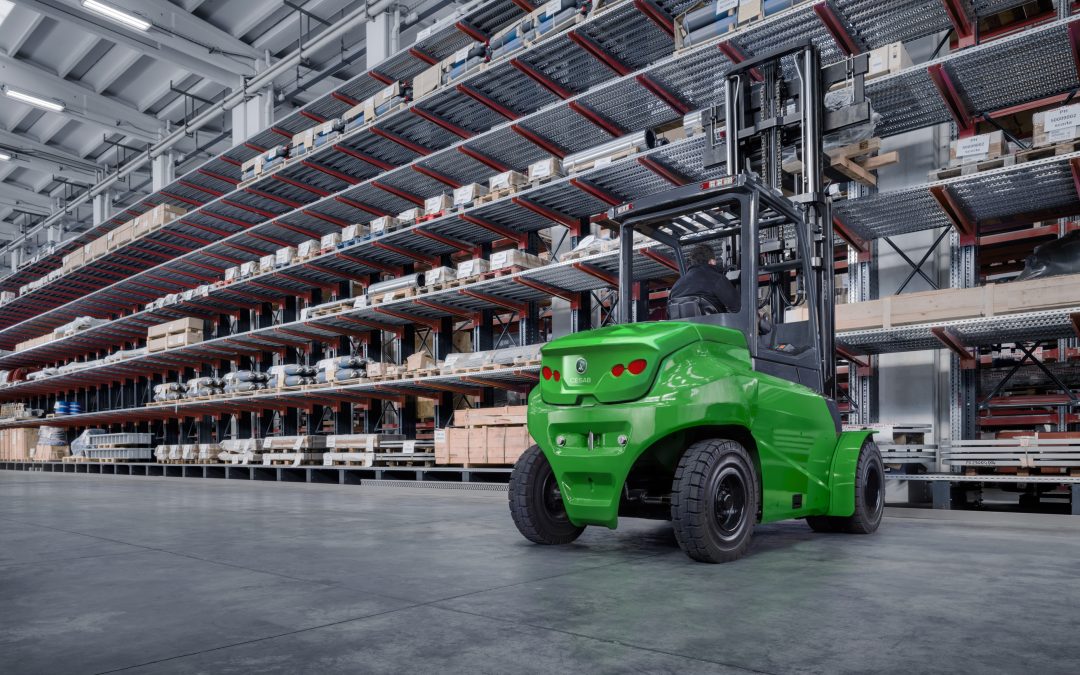To operate your warehouse seamlessly, it’s essential to have the correct equipment on hand at all times. One of the most essential pieces of equipment you can have in your arsenal is a counterbalance forklift truck, but what is a counterbalance forklift truck and what is it used for? Let’s take a look.
What is a counterbalance forklift truck?
A counterbalance forklift truck is the most common type of forklift and is designed with two forks at the front, a counterweight at the rear and either three or four wheels. Counterbalance forklift trucks are able to drive up close to a load to lift and move it, as the counterweight prevents the vehicle from tipping over. With their large turning circle and versatile design, counterbalance forklift trucks can be operated both outdoors and indoors in smooth, flat and open spaces.
Counterbalance forklift vs reach truck
Unlike counterbalance forklift trucks, reach forklifts are designed to operate indoors (such as warehouses) and can weave through narrow aisles. They’re primarily designed to lift loads that sit in high places in storage or racking and use their stabilising legs to extend their reach. The unique tilt mechanism and open overhead guard of a reach truck are designed to help the driver get a better view of their task, and they also have a camera installed so that the driver can see above their head on a video screen.
Do you need a license to operate a counterbalance forklift truck?
To become a counterbalance forklift truck driver, you must first obtain your counterbalance forklift truck licence. You don’t need any prior experience to start training with an accredited counterbalance forklift truck training provider, so after completing 3-6 days of training, you’ll be able to take your theory and practical skills test. Once you have acquired your licence, you’ll be able to operate a counterbalance forklift truck legally.
What are the benefits of counterbalance forklift trucks?
Large capacity
The unique design of counterbalance forklifts means that the larger they are, the more weight they can carry. The in-built counterbalance must be large enough to equal or exceed the weight of the load picked up by the tynes so that the unit does not tip over. On average, counterbalance forklifts can lift between 1.8T to 48T, so they can be used for a wide variety of operations.
Variety of fuel types
Counterbalance forklifts can be powered by a variety of fuel types to suit the unique requirements of your warehouse. You can choose from electric, petrol, diesel or LPG forklifts, depending on where the forklift will be operating and how heavy the loads it lifts will be. For example, a diesel-powered counterbalance forklift is ideal for lifting and manoeuvring heavy, large loads, such as containers, while battery-powered counterbalance forklifts are better suited for indoor operation where ventilation may be an issue, as they do not emit any harmful gases.
Sustainable
Businesses all over the UK are becoming more environmentally conscious than ever, so if you’re looking to keep your carbon emissions at a minimum, counterbalance forklifts are a great option. The carbon footprint of your counterbalance forklift will depend on the type of fuel it uses to operate, so if you’re looking to make your business operations more eco-friendly, electric counterbalance forklifts are a great option, as they produce almost zero emissions.
Save money
The cost of operating and maintaining a counterbalance forklift will depend on which type of fuel you use to power it. Electric counterbalance forklifts, for example, are much cheaper to run than gas or diesel-powered counterbalance forklifts as they only require water to top them up and electricity to recharge the battery. If you’re looking to cut fuel costs in your business, electric counterbalance forklifts could be a great option.
Indoor and outdoor operation
Counterbalance forklifts can be adapted to suit a variety of environments, both indoors and outdoors. Different tyres can be installed to suit different uses, from solid and cushion tyres to non- marking and pneumatic tyres. Non-marking tyres, for example, are ideal for counterbalance forklifts operating indoors, as they will not damage the floor of your warehouse. Pneumatic tyres, however, are ideal for outdoor operation, as they are made with heavy-duty, durable rubber and are designed with deep treads, so they can withstand regular use on a variety of outdoor surfaces.
Browse our range
If you’re looking for electric, gas or diesel counterbalance forklift trucks, at Pendle Forklift Services, we have a wide range of products available for long or short term hire. Shop our range today or get in touch with our friendly and professional team by giving us a call on 01282 911 958 or fill in our online contact form here if you have any questions.

 01282 842 678
01282 842 678